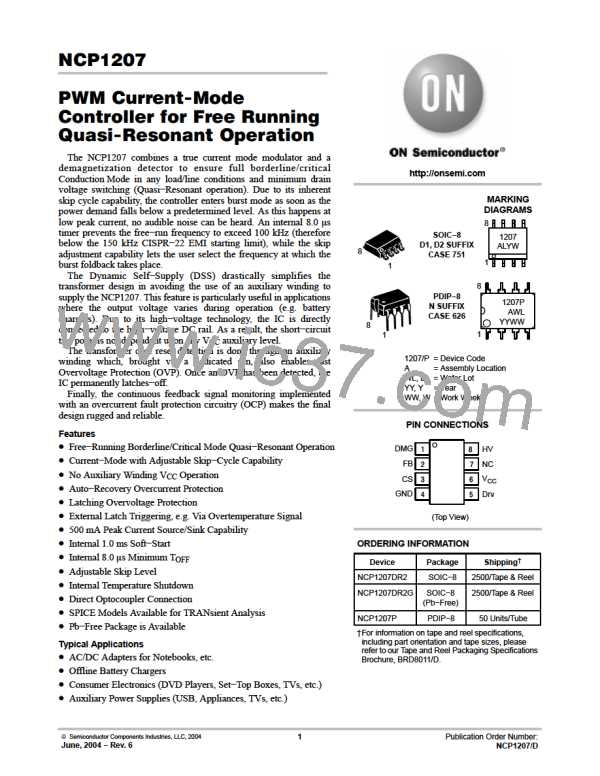NCP1207
Application Information
Introduction
occurs at low peak current. This point guarantees a
noise−free operation with cheap transformer. This
option also offers the ability to fix the maximum
switching frequency when entering light load
conditions.
The NCP1207 implements a standard current mode
architecture where the switch−off time is dictated by the
peak current setpoint whereas the core reset detection
triggers the turn−on event. This component represents the
ideal candidate where low part−count is the key parameter,
particularly in low−cost AC/DC adapters, consumer
electronics, auxiliary supplies, etc. Thanks to its
high−performance High−Voltage technology, the NCP1207
incorporates all the necessary components / features needed
to build a rugged and reliable Switch−Mode Power Supply
(SMPS):
• Overcurrent Protection (OCP): by continuously
monitoring the FB line activity, NCP1207 enters burst
mode as soon as the power supply undergoes an
overload. The device enters a safe low power operation
which prevents from any lethal thermal runaway. As
soon as the default disappears, the power supply
resumes operation. Unlike other controllers, overload
detection is performed independently of any auxiliary
winding level. In presence of a bad coupling between
both power and auxiliary windings, the short circuit
detection can be severely affected. The DSS naturally
shields you against these troubles.
• Transformer core reset detection: borderline / critical
operation is ensured whatever the operating conditions
are. As a result, there are virtually no primary switch
turn−on losses and no secondary diode recovery losses.
The converter also stays a first−order system and
accordingly eases the feedback loop design.
Dynamic Self−Supply
• Quasi−resonant operation: by delaying the turn−on
event, it is possible to re−start the MOSFET in the
minimum of the drain−source wave, ensuring reduced
EMI / video noise perturbations. In nominal power
conditions, the NCP1207 operates in Borderline
Conduction Mode (BCM) also called Critical
Conduction Mode.
The DSS principle is based on the charge/discharge of the
V
bulk capacitor from a low level up to a higher level. We
CC
can easily describe the current source operation with some
simple logical equations:
POWER−ON:IF V < VCC
THEN Current Source
CC
OFF
is ON, no output pulses
IF V decreasing > VCC THEN Current Source is
CC
ON
• Dynamic Self−Supply (DSS): due to its Very High
Voltage Integrated Circuit (VHVIC) technology,
ON Semiconductor’s NCP1207 allows for a direct pin
connection to the high−voltage DC rail. A dynamic
current source charges up a capacitor and thus provides
OFF, output is pulsing
IF V increasing < VCC
THEN Current Source is
CC
OFF
ON, output is pulsing
Typical values are: VCC
= 12 V, VCC = 10 V
ON
OFF
a fully independent V level to the NCP1207. As a
CC
To better understand the operational principle, Figure 16’s
sketch offers the necessary light.
result, there is no need for an auxiliary winding whose
management is always a problem in variable output
voltage designs (e.g. battery chargers).
V
= 2 V
RIPPLE
• Overvoltage Protection (OVP): by sampling the plateau
voltage on the demagnetization winding, the NCP1207
goes into latched fault condition whenever an
VCC
= 12 V
OFF
VCC = 10 V
ON
overvoltage condition is detected. The controller stays
fully latched in this position until the V is cycled
CC
down 4.0 V, e.g. when the user un−plugs the power
supply from the mains outlet and re−plugs it.
ON
• External latch trip point: by externally forcing a level
on the OVP greater than the internal setpoint, it is
possible to latch−off the IC, e.g. with a signal coming
from a temperature sensor.
OFF
Output Pulses
• Adjustable skip cycle level: by offering the ability to
tailor the level at which the skip cycle takes place, the
designer can make sure that the skip operation only
Figure 16. The Charge/Discharge Cycle Over a 10 mF
CC Capacitor
V
http://onsemi.com
8

 ONSEMI [ ONSEMI ]
ONSEMI [ ONSEMI ]